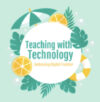Choosing to integrate technology into my teaching is not just a decision but a commitment to enhancing the learning experience for today’s tech-immersed students. In this reflection, I’ll explore my motivations for incorporating technology into teaching, the rationale behind enrolling in the ‘Teaching with Technology’ course, and how this aligns with the requirements for the PIDP 3240 equivalency credit.
Why I want to teach with technology?
My decision to embrace technology in teaching is rooted in recognizing its transformative impact on learning. Technology offers a diverse array of tools and resources to captivate students, cater to various learning styles, and prepare them for a digitally-driven world.
1. Teaching with technology allows for crafting engaging and relevant learning experiences by integrating multimedia, interactive simulations, and digital content, connecting subject matter to real-world applications.
2. Technology enables the customization of learning experiences to meet individual student needs. Adaptive learning platforms, online assessments, and interactive educational games facilitate personalized learning paths.
3. In a world where digital literacy is paramount, teaching with technology equips students with technological competence and digital citizenship, fostering skills like critical thinking, collaboration, and information literacy.
4. Technology breaks down geographical barriers, fostering global connectivity and collaboration. Virtual classrooms, online forums, and collaborative tools enable students to interact with peers worldwide, promoting a global perspective and cultural awareness.
5. Integrating technology streamlines administrative tasks, making it easier to organize and manage instructional materials. Learning management systems, digital grading tools, and communication platforms enhance efficiency, allowing more time for meaningful interaction with students.
Choosing the ‘Teaching with Technology’ Course
Enrolling in the ‘Teaching with Technology’ course was a deliberate choice driven by the need for specialized knowledge and skills to effectively integrate technology into teaching. The course offered a structured and comprehensive exploration of various aspects related to teaching with technology, serving as a valuable resource for professional development.
1. The course delved into a variety of educational technologies, providing hands-on experience with their features, applications, and best practices, covering everything from learning management systems to interactive presentation tools.
2. Beyond technical aspects, the course focused on pedagogical strategies for seamlessly incorporating technology into the curriculum, emphasizing the alignment of technology with learning objectives and effective instructional design principles.
3. The course critically examined ethical considerations and inclusivity in teaching with technology, addressing privacy concerns, ensuring accessibility, and promoting equitable access to technology, aligning with broader ethical considerations in education.
4. Through various classroom (online) activities, the course facilitated hands-on application, encouraging participants to design technology-integrated lesson plans and assessments. This practical component was crucial for translating theoretical knowledge into actionable strategies.
5. Collaborating with peers in the course allowed for the exchange of ideas, experiences, and insights. Learning from diverse perspectives enriched the course experience, providing a broader understanding of the challenges and opportunities in teaching with technology.
Qualifying for PIDP 3240 Equivalency Credit
Completing the ‘Teaching with Technology’ course aligns with the requirements for the PIDP 3240 equivalency credit due to its comprehensive coverage of key competencies outlined in the PIDP 3240 course description.
1. The ‘Teaching with Technology’ course aligns with the competencies specified in PIDP 3240, including the exploration of educational technologies, consideration of ethical and inclusive practices, and the development of pedagogical strategies for effective integration.
2. The course’s emphasis on hands-on application, assignment development, and creation of technology-integrated lesson plans and activities directly addresses the practical components outlined in PIDP 3240, selecting appropriate technologies for teaching purposes
Photo by Glenn Carstens-Peters on Unsplash

